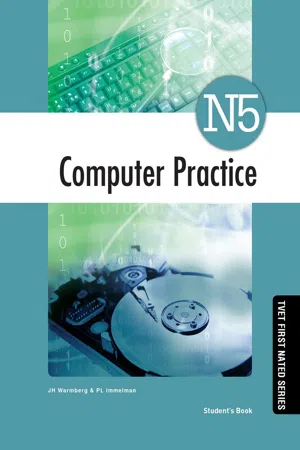
eBook - PDF
Computer Practice N5 SB
TVET FIRST
J Warmberg, P Immelman
This is a test
- English
- PDF
- Available on iOS & Android
eBook - PDF
Computer Practice N5 SB
TVET FIRST
J Warmberg, P Immelman
Book details
Table of contents
Citations
About This Book
Lots of varied activities facilitate learning.Relevant and interesting content.All key concepts are thoroughly explained.
Frequently asked questions
At the moment all of our mobile-responsive ePub books are available to download via the app. Most of our PDFs are also available to download and we're working on making the final remaining ones downloadable now. Learn more here.
Both plans give you full access to the library and all of Perlego’s features. The only differences are the price and subscription period: With the annual plan you’ll save around 30% compared to 12 months on the monthly plan.
We are an online textbook subscription service, where you can get access to an entire online library for less than the price of a single book per month. With over 1 million books across 1000+ topics, we’ve got you covered! Learn more here.
Look out for the read-aloud symbol on your next book to see if you can listen to it. The read-aloud tool reads text aloud for you, highlighting the text as it is being read. You can pause it, speed it up and slow it down. Learn more here.
Yes, you can access Computer Practice N5 SB by J Warmberg, P Immelman in PDF and/or ePUB format, as well as other popular books in Business & Business generale. We have over one million books available in our catalogue for you to explore.
Information
Table of contents
- JH Warmberg & PL Immelman
- Computer Practice N5_A4..pdf
- Contents
- Module 1: Keyboarding
- Unit 1.1: Concepts relating to computers
- Unit 1.2: Operating the computer
- Unit 1.3: Windows 7 commands
- Module 2: Word processing usingMS Word 2010
- Unit 2.1: The concept of word processing
- Unit 2.2: Features of MS Word
- Unit 2.3: Creating and saving a new document
- Unit 2.4: Basic formatting of a document
- Unit 2.5: Viewing and printing documents
- Unit 2.6: Advanced formatting functions
- Unit 2.7: Headers, footers and page numbers
- Unit 2.8: Breaks
- Unit 2.9: Formatting lines
- Unit 2.10: Formatting page margins
- Unit 2.11: Footnotes and endnotes
- Unit 2.12: Working with blocks of text
- Unit 2.13: Using Mail Merge
- Module 3: Spreadsheets usingMS Excel 2010
- Unit 3.1: The concept of spreadsheets and opening MS Excel
- Unit 3.2: Features of MS Excel
- Unit 3.3: Creating and saving a workbook or spreadsheet
- Unit 3.4: Moving and copying cells
- Unit 3.5: Inserting and deleting cells, rows, columns and sheets
- Unit 3.6: Formatting row height and column width
- Unit 3.7: Organising the worksheet
- Unit 3.8: Using the Workbook Views Grouping
- Unit 3.9: The Zoom function
- Unit 3.10: Viewing the worksheet windows
- Unit 3.11: Formatting the datasheet
- Unit 3.12: Formatting numbers
- Unit 3.13: Using formulas
- Unit 3.14: Using the date function and system date
- Unit 3.15: Aligning text
- Unit 3.16: Sorting and filtering data
- Unit 3.17: Printing the workbook
- Unit 3.18: Formatting visibility
- Unit 3.19: Creating charts
- Module 4: Databases
- Unit 4.1: Understanding the concept of a database and opening MS Access
- Unit 4.2: Features of MS Access
- Unit 4.3: Managing the database table
- Unit 4.4: Editing the table
- Unit 4.5: Editing the database structure in Design View
- Unit 4.6: Sorting and filtering records
- Unit 4.7: Creating a query
- Unit 4.8: Generating reports
- Glossary
- Back cover